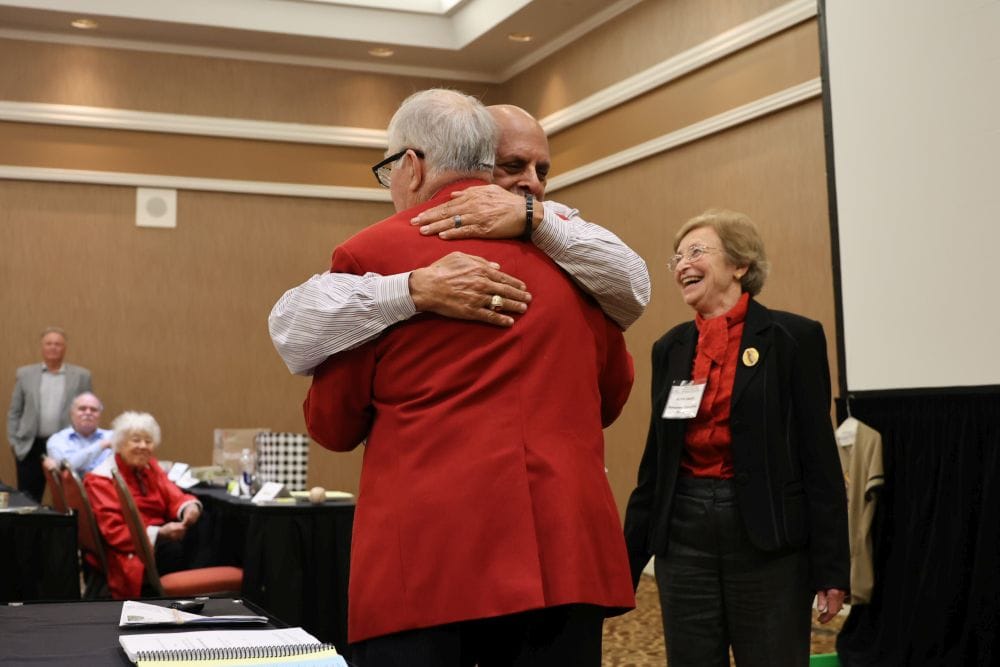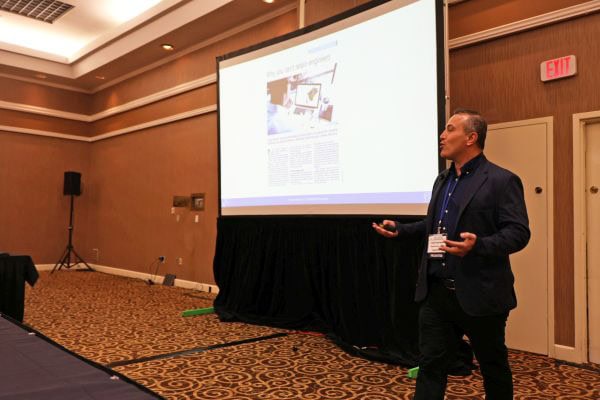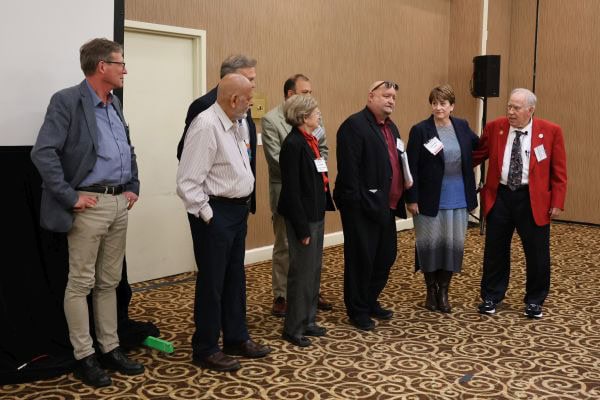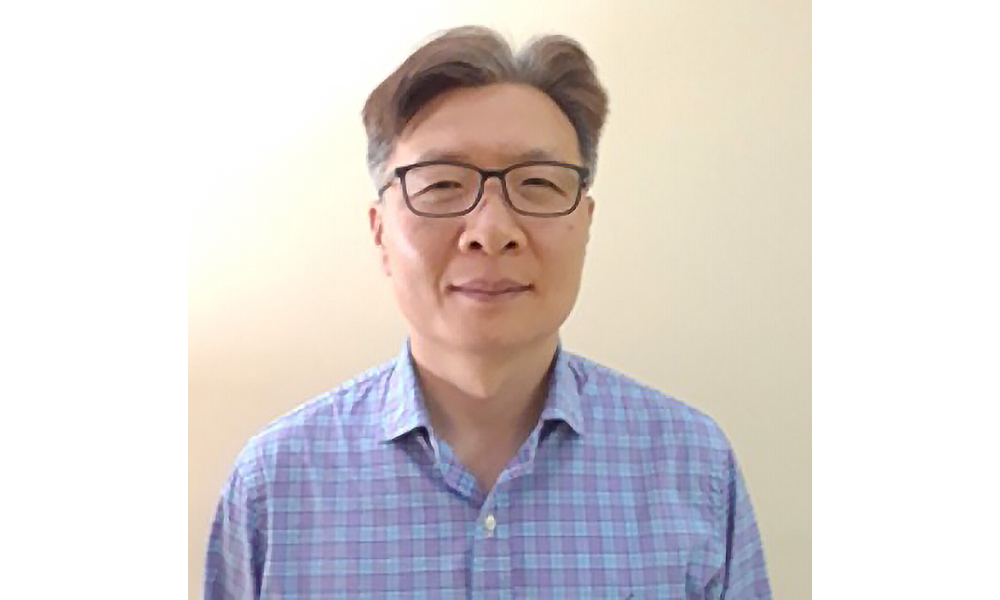
[Image above] Dilip Jain gives Kent Weisenstein (red jacket) a hug during a session recognizing past Theodore J. Planje Refractories Award recipients. Another past Planje recipient, Ruth Engle, stands nearby. Credit: ACerS
Though relatively few in numbers, the 60th Annual Symposium on Refractories co-hosted by the ACerS Greater Missouri Section and Refractory Ceramics Division was truly a global event. Approximately 220 attendees from 15 countries gathered at the Hilton Airport Hotel in St. Louis from March 25–27, 2025, to discuss an increasingly impactful technology in industry: artificial intelligence.
This year’s meeting was only the second one for Brady Gould of Christy Refractories, who co-programed the event along with Rebecka Annunziata of ArcelorMittal. But even from just two events, Gould says that the camaraderie binding long-standing and new members together in the refractories community is evident and “something special.”
“I think many people in the refractories industry would agree, we would always welcome and love to see more young people in attendance and getting involved,” Gould says. “These guys here won’t be around forever, so it’s up to us and the future generation to mine as much knowledge and experience as possible in order to keep our industry healthy and expanding.”
Below are highlights from the 60th Annual Symposium on Refractories.
Growing the workforce through digitalization
Recruitment and retainment of personnel are two perennial challenges for manufacturers. Determining why there is such high turnover with younger workers is a pressing question, and the symposium’s first speaker, Yakup Bayram of PaneraTech, Inc., had an answer.
His company recently interviewed glass manufacturing executives and engineers from around the world to find out why workers leave the industry after only a few years. While the executives believed this behavior was due to the perception of glass manufacturing as a “dirty, low-profile industry,” the engineers explained it was actually due to the tiring “firefighting” approach to operations. In other words, they spent all their time responding to emergencies (putting out fires) rather than proactively preventing them.
The PaneraTech report suggested that digitalization could help alleviate worker burnout and discouragement in the glass and other heavy industries, such as steel and refractories, by supporting optimized operations and preventative maintenance. Of course, data on processes and equipment are only useful when people engage with the information. Bayram described some best practices for doing so, including the need for human oversight because no data collection setup is infallible.

Yakup Bayram of PaneraTech, Inc. kicked off the 60th Annual Symposium on Refractories by discussing how digitalization could help improve industry worker recruitment and retention. Credit: ACerS
Harnessing conventional and AI-driven models and simulations in industry
Bayram’s opening talk served as the perfect introduction to the rest of the presentations, which demonstrated the many ways that refractory, steel, and other manufacturers in related industries are making use of conventional and AI-driven models and simulations to improve their operations.
Across all talks, the limitations as well as benefits of digitalization were discussed in depth. Many of the featured techniques are emerging science, after all, and seeing how manufacturers such as RHI Magnesita, MiNTEQ, and Almatis accounted for and adjusted to these restrictions in real time provided invaluable insights for other attendees considering using these techniques in their operations.
Some of the advanced modeling techniques discussed during the presentations are featured in the March 2025 Bulletin. Explore the feature stories and columns at this link.
Celebrating new and past RCD and Greater Missouri Section award winners
Two awards are traditionally given at the Refractories Symposium: the Refractory Ceramics Division’s biennial Alfred W. Allen Award, which recognizes the author(s) of the best technical paper on refractory ceramics published in the last two years, and the Greater Missouri Section’s Theodore J. Planje Refractories Award, which recognizes individuals who show excellence in the field of refractories.
This year’s Allen Award recipients were Somnath Mandal and Manoj Mahapatra of the University of Alabama at Birmingham and James G. Hemrick of Oak Ridge National Laboratory for their 2023 paper “Impact on aggregate/matrix bonding when a refractory contains zinc aluminate instead of spinel and magnesia-chrome.” Mandal presented the award lecture, and he said winning this award was his “dream” because his work has now achieved the same level of recognition as some of his mentors.

Ruth Engle, left, presented this year’s Allen Award to Somnath Mandal, James Hemrick, and Manoj Mahapatra. Credit: ACerS
Regarding the Planje Award, instead of a new recipient, the Greater Missouri Section decided to recognize all past Planje recipients in honor of it being the 60th Annual Symposium. Past Planje recipient and ACerS Distinguished Life Member Kent Weisenstein gave a speech reflecting on his years in the refractories industry and as an ACerS member. Several other past Planje recipients then shared their memories of Weisenstein and what it means to be a Planje recipient.

Past Theodore J. Planje Refractories Award recipients, from left: Andreas Buhr, Dilip Jain, David Tucker, Ruth Engel, James Hemrick, Jeffrey Smith, Nancy Bunt, and Kent Weisenstein. Credit: ACerS
See more photos from the 60th Annual Symposium on Refractories on the ACerS Flickr page. We look forward to seeing you in St. Louis next year!
Author
Lisa McDonald
Spotlight Categories
- Division News
- Meeting Highlights
- Section News
Divisions
- Refractory Ceramics
U.S. Sections
- Greater Missouri
Related Posts
Volunteer spotlight: Hyunjun Kim
December 18, 2025
ACerS GOMD History – A Look Back in Time
December 10, 2025


